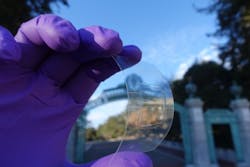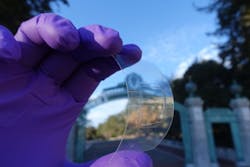Twisting and Bending a Layer of Semiconductor Materials in an LED Boosts its Efficiency
Engineers at Berkeley Lab have come up with a simple way to increase an LED’s efficiencies. Smartphones, laptops and lighting applications rely on LEDs to shine bright. But until now, the brighter they shone, the more inefficient they became, releasing more energy as heat instead of light.
The Berkeley team focused on stretching or compressing a thin semiconductor film so that its electronic structure changed. This structure dictates how energetic particles within the material will interact. The particles sometimes collide and annihilate each other, losing energy as heat instead of emitting light. Changing the electronic structure can lower the likelihood for annihilation and lead to a near-perfect conversion of energy to light, even at high brightness levels.
“It’s always easier to emit heat than light, particularly at high brightnesses,” says Ali Javey, a scientist at Berkeley Lab and an electrical engineering and computer sciences professor at UC Berkeley.
The Berkeley teams discovered the phenomenon using a three-atom-thick layer of a semiconductor material, a transition metal dichalcogenide, that was subjected to mechanical strain by bending and twisting it. These films can have unusual crystal structure that gives them electronic and optical properties: When their atoms are excited by passing an electric current or shining a light on it, energetic particles called excitons are created.
Excitons release their energy either by emitting light or heat. The efficiency with which excitons emit light as opposed to heat determines an LED’s ultimate performance.
“It was relatively simple to get near-perfect light-emission efficiency at low exciton concentrations,” says Shiekh Zia Uddin, a UC Berkeley graduate student. He and his colleagues had shown that chemically or electrostatically charging single-layered materials could lead to high-efficiency conversion, but only for a low concentration of excitons.
For the high exciton concentrations, which is where most optical and electronic devices typically operate, too many excitons annihilate each other. It seems that when more excited particles are created, the balance tilts toward creating more heat instead of light.
This led the Berkeley team to theorized that the path to a high performance for high exciton concentrations was through tweaking the material’s band structure. So, they then proposed and tested modifying the band structure in a controlled way using physical strain.
The researchers started by carefully placing a thin semiconductor (tungsten disulfide, or WS2) film atop a flexible plastic substrate. They bent the plastic substrate to apply a small amount of strain to the film. At the same time, the researchers focused a laser beam on the film and varied its intensities. They observed that more intense beams led to a higher concentration of excitons and a high “brightness” level.
Detailed optical microscope measurements let the team observe the number of photons emitted by the material as a fraction of the photons it had absorbed from the laser. The researchers found the material emitted light at nearly perfect efficiency at all brightness levels if the right strain was applied.
To further understand the material’s behavior under strain, the team performed analytical modeling. It found that heat-losing collisions between excitons are enhanced due to “saddle points” found naturally in the single-layer semiconductor’s band structure.
Applying mechanical strain slightly changed the energy of that process, pulling excitons away from the saddle points. This reduced the particles’ tendency to collide; losing efficiencies at high concentrations of charged particles should no longer be an insurmountable problem.
“These single-layer semiconductor materials are intriguing for optoelectronic applications, as they provide high efficiency even at high brightness levels and despite the presence of large number of imperfections in their crystals,” says Javey.
Future work by the Berkeley Lab team will focus on using the material to fabricate actual LED devices to further test the technology’s efficiency under increasing brightness.

